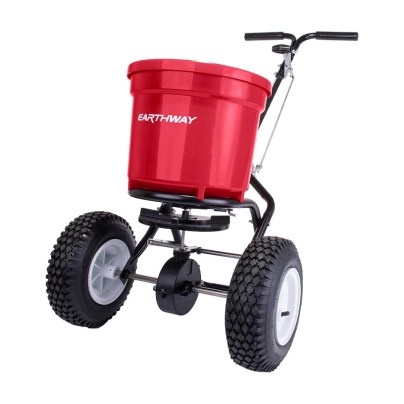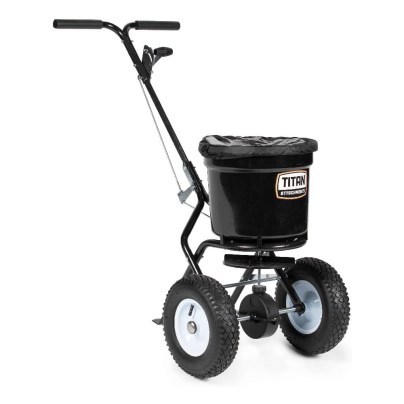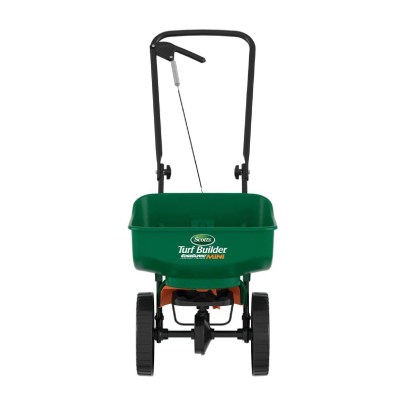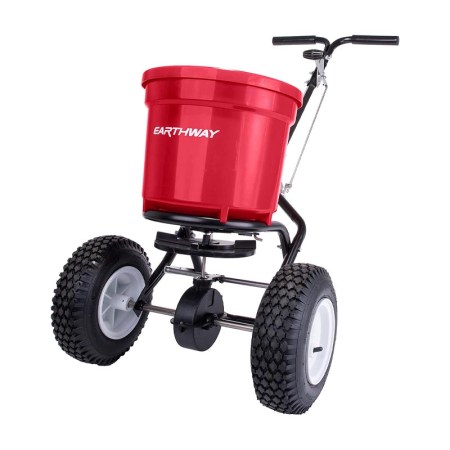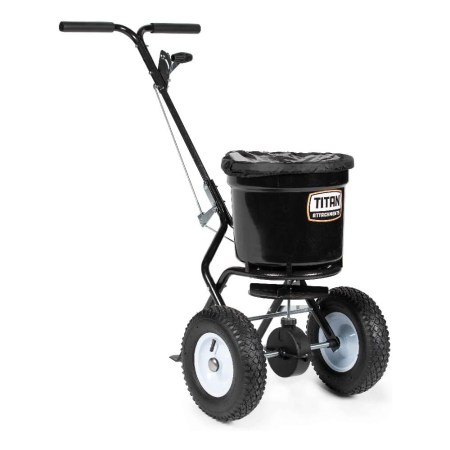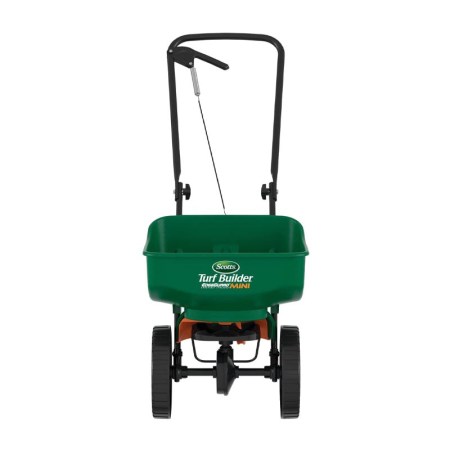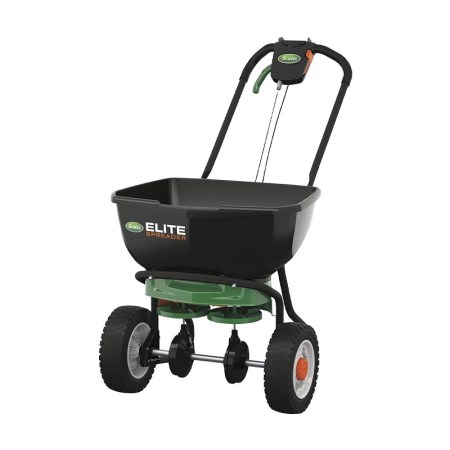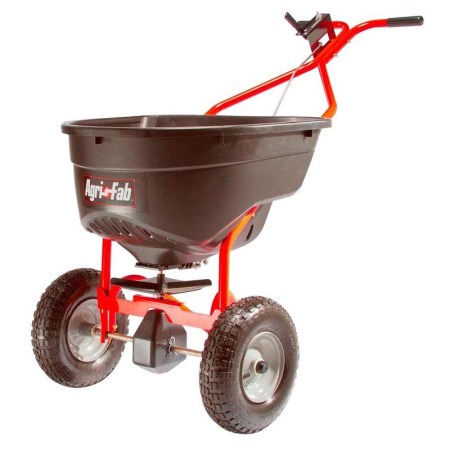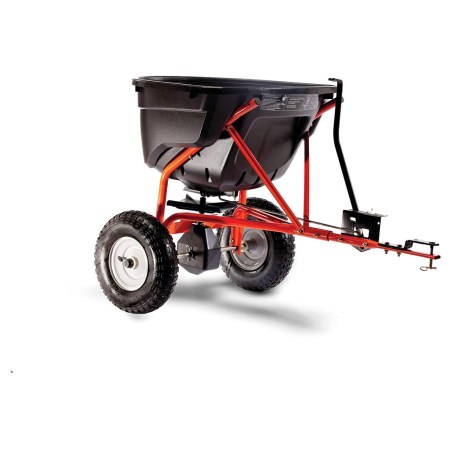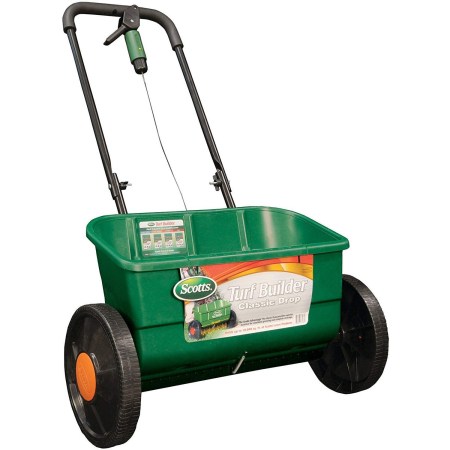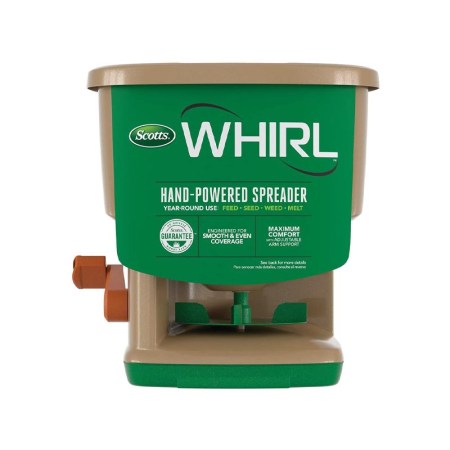We may earn revenue from the products available on this page and participate in affiliate programs. Learn More ›
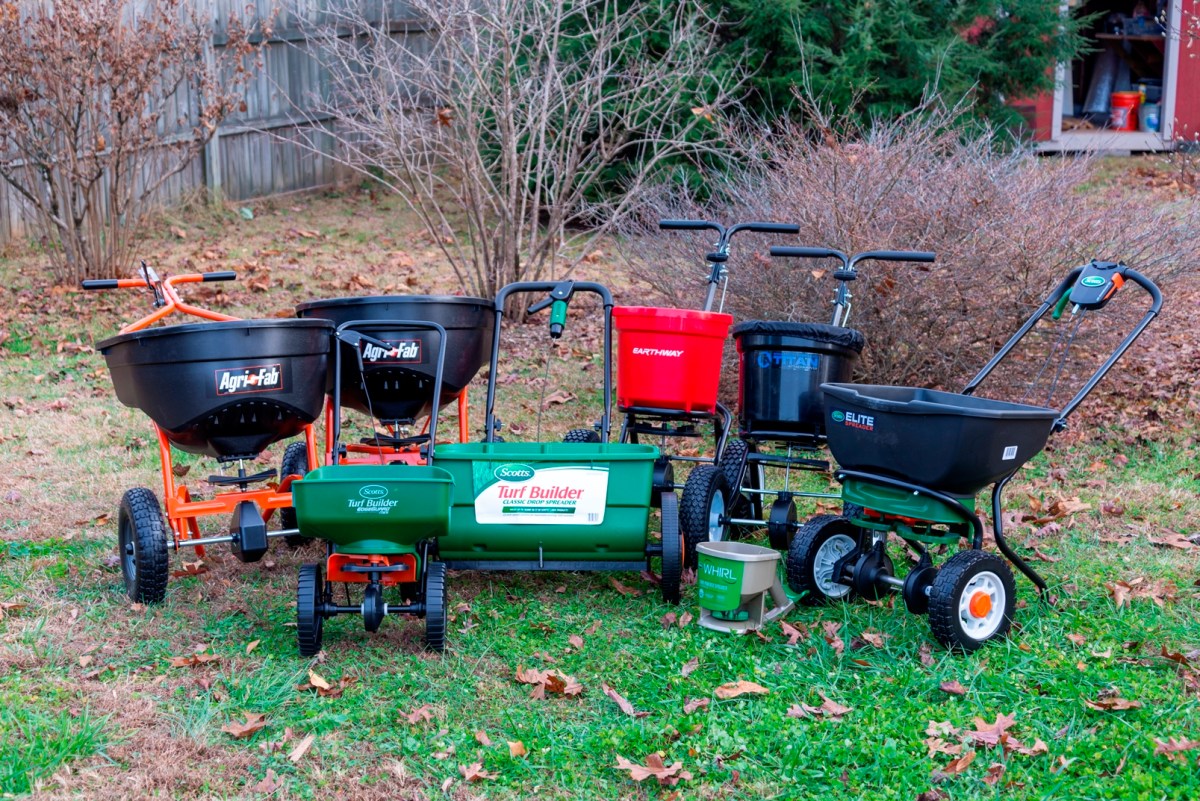
Whether seeding a new lawn, feeding an existing garden, or treating a yard for bug infestations, a fertilizer spreader is an invaluable tool. Sure, seeds and fertilizer can be spread by hand, but it takes longer, produces inconsistent results, and it puts the user in contact with potentially dangerous chemicals.
A fertilizer spreader may be used to apply any lawn treatment, including grass seed, lime, insecticide, fungicide, and of course, fertilizer. These machines apply products evenly so that the entire yard can be treated, resulting in less product waste and less time and effort. A fertilizer spreader may also be used in the off-season to spread salt on icy walkways and paths.
We researched and tested some of the highest-rated fertilizer spreaders available. We also spoke to Taylor Olberding, co-founder of Heroes Lawn Care, a nationwide lawn maintenance company, to get his professional opinion. Just ahead, our results and the shopping considerations we’ve outlined will narrow the field and help you find the right kind of spreader.
- BEST OVERALL: Earthway 2150 Commercial Broadcast Spreader
- RUNNER-UP: Titan Broadcast Spreader
- BEST BANG FOR THE BUCK: Scotts Turf Builder EdgeGuard Mini Broadcast Spreader
- UPGRADE PICK: Scotts Elite Spreader
- BEST FOR LARGE YARDS: Agri-Fab 45-0462 Push Broadcast Spreader
- BEST PULL-BEHIND: Agri-Fab 45-0463 Tow Behind Broadcast Spreader
- BEST DROP: Scotts Turf Builder Classic Drop Spreader
- BEST HANDHELD: Scotts Whirl Hand-Powered Spreader
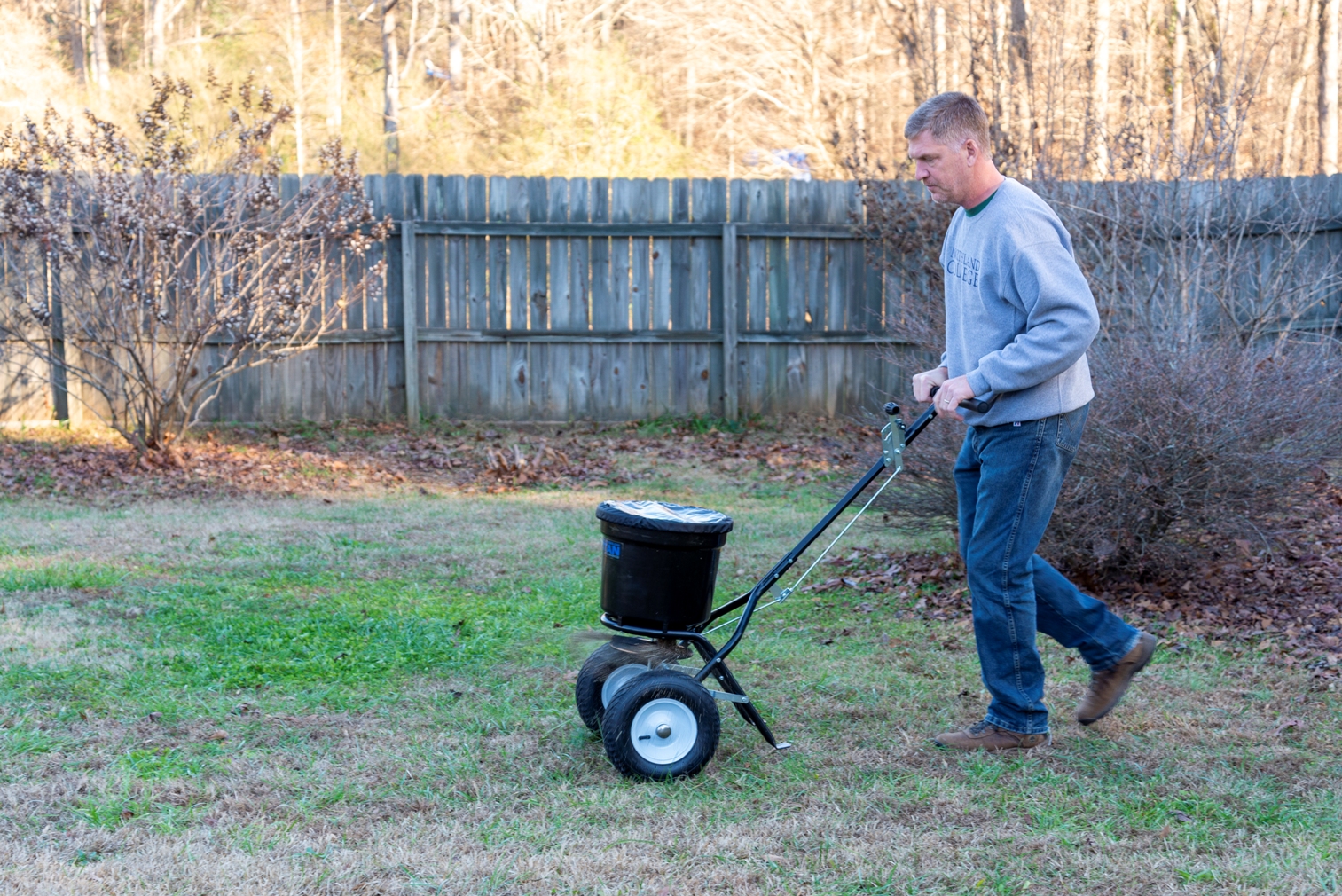
How We Tested the Best Fertilizer Spreaders
Olberding says that in terms of stand-out features to look for in a spreader, “ensure it has air-filled tires (not plastic tires) and is made of stainless steel/noncorrosive material with a plastic hopper and can be easily configured based on the fertilizer product.” He also adds, “Ensure you are able to adjust the openings for accurate application and have an edge guard to help prevent fertilizer from spreading onto nontarget areas.”
Taking this expert advice in mind, we wanted to review the most critical features of these tools to determine where each model would work best. In a real-world setting, the most important functions include distribution width, accuracy, and consistency; ease of controlling the on-off function while in motion; maneuverability over varying terrain; and user comfort. We also wanted to evaluate and share the difficulty of assembly and amount of time spent in assembly and calibration.
After assembly, we loaded each spreader with lawn fertilizer and ran it across a tarp on level ground to measure the discharge width and consistently. At the same time, we tested the on-off functionality while moving, which is important at start-up and when preparing for end turns. Finally, we pushed or pulled each spreader through a variable-terrain course, observing the way it rolled over bumps and dips and navigated corners.
We found that the rotary spreaders compared closely with one another on the tarp-surface test. The handheld and the Scotts mini cast a 4- to 5-foot path, while the larger models discharged a swath just over 6 feet wide, all with a moderate amount of consistency. The drop spreader was highly consistent, dropping an even layer measuring precisely the width between its own wheels. Air-filled tires consistently performed significantly better than hard plastic wheels on the terrain test.
Testing Stats
Products tested: 8
Hours spent testing: 3 hours per product
Tests performed: 3
Average price: $150
Our Top Picks
Consider the top picks laid out below and our findings when we tested out each. We chose these models for testing based on their overall spreading capacity, holding capacity, precision, and method of operation. Read on to find out how each one performed in our hands-on testing.
Our Ratings: Durability 5/5; Maneuverability 5/5; Ease of Assembly 5/5; Storage 3/5
Product Specs
- Type: Walk-behind, rotary
- Capacity: 50 pounds
- Flow controller: Sliding lever
Pros
- Heavy-duty components including a steel T-handle, epoxy-coated frame, and pneumatic stud tires
- Easy to operate and maneuver while holding up to 50 pounds of fertilizer
- Comes with easy-to-follow instructions for assembly and use
Cons
- Higher price than the competition
- Bulky, may be difficult to store in smaller spaces without disassembly
- Does not include a rain cover
The Earthway 50-pound walk-behind broadcast spreader is a commercial-grade multiuse spreader that measures 24.75 inches high by 16 inches wide by 16 inches deep. The heavy-duty plastic hopper handles yards measuring from 10,000 square feet up to an acre. The two-position height adjustment handle and the
T-speed lever provide excellent operator comfort and control for users of different heights. The even-spread three-hole drop shutoff system ensures a consistent spread pattern and a feathered spread edge ensures a smooth application.
The frame is engineered with a 175-pound load-bearing limit for durability under rugged operating conditions such as uneven terrain. The 13-inch-diameter stud tires on rustproof, poly-constructed rims provide long-term durability and smooth operation. The commercial-grade, super-duty gearbox is built to last for years. Users can expect to spend a few hours on the assembly and calibration of this spreader.
In testing, we appreciated the easy-to-follow assembly instructions and heavy-duty components. This spreader feels durable, is comfortable to operate, and easy to control. The heavy-duty poly hopper holds 50 pounds of fertilizer. Fully loaded, the air-filled pneumatic stud tires rolled effortlessly, even on slopes and rough ground, cushioning bumps to maintain a highly consistent distribution pattern. In addition to being an excellent choice for year-round use for fertilizer and grass seed, this Earthway model would also work well with ice-melting products.
Get the Earthway fertilizer spreader at Amazon or The Home Depot.
Our Ratings: Durability 5/5; Maneuverability 5/5; Ease of Assembly 4/5; Storage 4/5
Product Specs
- Type: Walk-behind, rotary
- Capacity: 50 pounds
- Flow controller: Sliding lever
Pros
- Large hopper capacity of over 50 pounds; suitable for large lawn spaces
- Easy-to-use 3-position handle for controlling the flow of the fertilizer
- Includes a rain cover for those without a shed or room in the garage
- Durable construction is made with steel and plastic
Cons
- Instructions were not crystal clear for assembly and use
- Too large for most small- and medium-size yards
- Bulky size may be hard to store without disassembly
Titan’s broadcast spreader evenly distributes herbicides, fertilizers, insecticides, grass seed, and even ice melters; features a high-capacity 50-pound drum; and has a three-position gearbox that allows you to control product flow.
The manufacturer made this spreader from high-grade steel and heavy-duty plastic parts. It weighs 25 pounds, so it’s light enough to move but heavy enough to tackle hilly, root-filled rugged terrain. It rides on pneumatic tires so that you can run it on turf or sod without damage to the grass. Measuring 43 inches high by 21 inches wide by 14.5 inches deep, this spreader doesn’t require excessive storage space.
We liked that this model covered a wide path. It is probably best for open spaces that are 10,000 square feet and larger. On the downside, the assembly instructions could have been clearer. We spent about an hour assembling the spreader and another 15 minutes calibrating the flow rate.
Get the Titan fertilizer spreader at Amazon.
Our Ratings: Durability 3/5; Maneuverability 3/5; Ease of Assembly 5/5; Storage 5/5
Product Specs
- Type: Walk-behind, rotary
- Capacity: 25 pounds
- Flow controller: Dial and spring lever
Pros
- The unit comes precalibrated and fully assembled; folds down for storing
- Made with an EdgeGuard feature to keep fertilizer on lawns only; prevents spillage onto flower beds, sidewalks, and driveways
- Capable of spreading seed, fertilizer, feed, and ice melt products for all-season use
- Affordable price point compared to other options on this list
Cons
- Difficult to spread the last bit of material
- Requires more effort to maneuver over uneven ground
- Not as durable as some of the top models on the market
Scotts Turf Builder EdgeGuard mini broadcast spreader is small, lightweight, and easy to store in limited space, thanks in part to a fold-down handle on this 1-pound spreader that measures 45.25 inches high by 20 inches wide by 16 inches deep. It’s built to hold up to 5,000 square feet of lawn products, so it suits yards up to 10,000 square feet.
Users can use the control panel with precision rate settings for more accurate coverage. The EdgeGuard feature blocks coverage on the right side of the spreader to prevent the lawn treatment from being spread onto sidewalks or flower beds.
While testing, we appreciated that this lightweight spreader with hard plastic wheels requires no assembly. It comes at an affordable price and is calibrated.
When not in use, the handles fold down for easy storage. The skinny hard wheels did not roll as smoothly across uneven ground as air tires. Also, the final bits of the product tend to stick to the bottom of the spreader due to static.
Get the Scotts Turf Builder EdgeGuard fertilizer spreader at Amazon, Ace Hardware, or The Home Depot.
Our Ratings: Durability 4/5; Maneuverability 3/5; Ease of Assembly 4/5; Storage 4/5
Product Specs
- Type: Walk-behind, rotary
- Capacity: 60 pounds
- Flow controller: Dial and spring lever
Pros
- 2 rotors provide more consistent coverage than basic Scotts spreaders
- Large hopper holds up to 60 pounds of fertilizer; covers over 20,000 square feet
- Arrives calibrated and mostly preassembled for user convenience
- Folds down for easy storage in garages, sheds, and more
Cons
- Some fertilizer discharges toward the wheel when in use
- Wheels are not great for rough ground; may require some effort to push around
- Not ideal for smaller lawns and spaces
Load the Scotts Elite spreader with 60 pounds of product, or enough to cover up to 20,000 square feet, and you’ll have the work done in no time. The key to this spreader’s speedy operation is the twin discharge design that allows it to put out the product twice as fast. It lays down an even 6-foot-wide path.
This spreader is suitable for spreading all sorts of materials, including corrosive rock salt and other ice-melt products. The comfortable ergonomic handle includes a smartphone holder so you can stay connected as you work.
We liked how easily the Scotts Elite assembled; we simply snapped on the wheels and unfolded the handle. The soft plastic wheels roll much more easily over varying terrain than the standard hard-plastic wheels on less expensive Scotts spreaders, but not as well as air-filled tires. This would be a good all-around spreader for midsize suburban yards, especially in icy climates.
Get the Scotts Elite fertilizer spreader at Amazon, Lowe’s, Tractor Supply Co., or The Home Depot.
Our Ratings: Durability 4/5; Maneuverability 5/5; Ease of Assembly 2/5; Storage 2/5
Product Specs
- Type: Walk-behind, rotary
- Capacity: 130 pounds
- Flow controller: Sliding lever
Pros
- Huge capacity of 130 pounds for covering up to 25,000 square feet
- Large air-filled pneumatic tires are ideal for both even and rough terrain
- Smooth-operating control arm provides flow control when spreading
Cons
- The gearbox feels a bit undersized for the potential weight
- The coverage path could be wider; can spread seeds within 8 to 12 feet
- The steel frame will corrode over time
The Agri-Fab push broadcast spreader’s 130-pound capacity is designed for yards up to 1 acre in size. A steel rod flow-control arm makes it easy for users to open and close the rustproof poly-constructed hopper during spreading, and the heavy-duty 1-inch pneumatic tires offer a smooth ride even over roots and rocks or through dips in the yard.
For all that heft, the spreader weighs only 6.81 pounds and measures just 33.6 inches high by 27.1 inches wide by 48 inches deep. Depending on your speed and application, this spreader can cover 25,000 square feet of the ground.
We assembled this spreader in about an hour, and it took another 10 minutes or so to calibrate it. The giant hopper appears to hold close to three times as much as the 50-pound spreaders we tested. Although we did not load it to capacity with fertilizer, we placed more than 100 pounds of weight on the hopper to see how it would move, and there were no problems. Although the hopper capacity is significantly greater, the path of coverage was about the same as the 50-pounders, so the savings would be on reloading time.
Get the Agri-Fab 45-0462 fertilizer spreader at Amazon.
Our Ratings: Durability 4/5; Maneuverability 4/5; Ease of Assembly 3/5; Storage 2/5
Product Specs
- Type: Tow, rotary
- Capacity: 130 pounds
- Flow controller: Sliding lever
Pros
- Stable design’s low center of gravity is ideal for towing on flat or uneven surfaces
- Large hopper capacity of 130 pounds can spread fertilizer on up to 25,000 square feet
- Short trailer tongue is easy to maneuver when hitched to a tractor, ATV, or automobile
Cons
- The steel frame material will corrode over time
- Control arm awkward to maneuver from mower seat
- The gearbox seems a bit undersized for the capacity of this model
A tow-behind spreader works well when spreading seed and other materials over an acre or more. Use this spreader’s universal hitch to couple the Agri-Fab tow-behind broadcast spreader with a lawn tractor, a riding lawn mower, or other tractor or vehicle. Users will find this spreader is quite maneuverable, and its spreading ability is even due to a steel-constructed direct flow control arm that users operate from the driver’s seat.
This spreader features a 130-pound capacity with a heavy-duty plastic hopper. It has 13-inch pneumatic tires and a steel frame.
We liked the squatty dimensions and 13-inch pneumatic tires when trying out this tow-behind model. The low height makes loading easier and leads to good stability on hilly ground. The short hitch length made it easy to maneuver around curves, but the control lever, located on the trailer tongue, was somewhat awkward to operate from the mower seat.
Get the Agri-Fab 45-0463 fertilizer spreader at Amazon, Tractor Supply Co., The Home Depot, or Northern Tool + Equipment.
Our Ratings: Durability 3/5; Maneuverability 3/5; Ease of Assembly 5/5; Storage 4/5
Product Specs
- Type: Walk-behind, drop
- Capacity: 32 pounds
- Flow controller: Dial and spring lever
Pros
- Extremely accurate application; comes with a built-in cable-driven gate control
- The heavy-duty frame is designed for long-term use
- Great for working near sensitive areas like flower beds and gardens
Cons
- May not provide the most even coverage on the ground
- May be too slow when applying fertilizers in large spaces
- Plastic wheels are not great for rough or uneven ground
The Scotts classic drop spreader has a large, heavy-duty plastic hopper that holds enough product to cover up to 10,000 square feet. Its 22-inch spread pattern provides excellent coverage and accuracy that users manage with a cable-driven gate control on the handle. The model measures 47 inches high by 32 inches wide by 18 inches deep.
The user selects any of the 23 spreader settings. To operate, squeeze the handle to open the hopper and loosen your grip to stop the flow.
We liked that this spreader came preassembled and calibrated. It laid a highly consistent path of fertilizer, but care must be taken to avoid gaps in coverage. Like the other Scotts spreaders, this one features hard plastic wheels that sometimes struggle on uneven ground or imperfect grass. The tubular frame seems strong and durable, but the other parts are mainly lightweight plastic. This spreader would make a good choice for occasional use on a small property, especially where numerous plant beds, sidewalks, tree rings, and other obstacles break up the lawn area.
Get the Scotts Turf Builder classic fertilizer spreader at Amazon, Lowe’s, Tractor Supply Co., or Ace Hardware.
Our Ratings: Durability 4/5; Maneuverability 5/5; Ease of Assembly 5/5; Storage 5/5
Product Specs
- Type: Handheld, rotary
- Capacity: 2 pounds
- Flow controller: Spring trigger and hand crank
Pros
- Small size takes up almost no storage space; can be stored on a shelf if needed
- Versatile and noncorrosive construction; can be used for seeds, fertilizer, weed, or ice melt
- Inexpensive option compared to other models on the market
Cons
- Less accurate than walk-behind types of spreaders
- Not suitable for spreading around small/fine particles
- Inconsistent flow compared to some other models available
The Scotts Whirl hand-powered spreader is a convenient year-round tool for small yards. The small size—it measures just 8.5 inches high by 8.7 inches wide by 13.1 inches deep and weighs just over a pound—is durable and easy to store. It’s constructed from plastic so you can spread fertilizer, ice melt, and other products without the worry that you’ll corrode the spreader as you might with metal counterparts.
We liked this spreader because it takes up almost no storage space and is super easy to operate. Fill the hopper, squeeze the trigger, and turn the handle to operate it. An adjustment dial controls the opening width, and the trigger opens the hopper gate to release the material as you turn the baseplate crank. A slide-out wrist support helped to steady the hopper and reduced operator fatigue while testing. This would be a good tool for patching bare spots with grass seed, treating small or difficult-to-reach grass areas, or for spreading ice-melt products.
Get the Scotts Whirl fertilizer spreader at Amazon, Lowe’s, Ace Hardware, or The Home Depot.
Jump to Our Top Picks
What to Consider When Choosing a Fertilizer Spreader
Before choosing a particular spreader, consider various features and the yard or area on which you want to use the tool. How much property will the spreader need to cover? Do you want to push the spreader by hand, or do you want to pull it behind a lawn tractor or other vehicle? Do you need one that is fully assembled? Consider the following criteria to make the proper choice for you.
Types of Fertilizer Spreaders
Two basic types of spreaders exist for dry applications––rotary spreaders, also known as broadcast spreaders—and drop spreaders. There are also spreaders designed for liquid chemicals.
Rotary/Broadcast Spreaders
A rotary spreader uses a rotating base plate to disperse seeds or granules that pour slowly from a hopper. They are called broadcast spreaders because they throw the product several feet to the front and sides of the spreader path.
Rotary spreaders cover an area three times their width, or broader, on every pass. These are the fastest tools you can use to spread dry materials, but their spreading abilities are less accurate than those of drop spreaders. Rotary spreaders are available in several sizes, so you can buy one that works for a tiny garden, a large estate lawn, and anything in the middle.
Drop Spreaders
When precision is critical, choose a drop spreader. These devices drop a swath of product through a wide, narrow opening directly beneath the spreader. They provide calibrated coverage, but the precision boosts the chance that the user will miss or double-cover an area.
For users who have a precise area to cover, this tool is ideal. Users can easily control where a drop spreader distributes the product because it only drops between its wheels. The downside is that users spend more time covering a lawn if using a drop spreader instead of a rotary spreader.
Liquid/Spray Spreaders
The most efficient way to spread liquid fertilizer and other liquid lawn treatments is with a hose-end chemical spreader/sprayer. These devices automatically mix the correct proportion of concentrated chemicals with a flowing stream of water that travels through the spreader and out the nozzle.
Liquid spreaders are especially useful as secondary tools for emergency treatments such as for bug infestations. They allow users to apply the coverage quickly, although they are less accurate than the other two types of spreaders. Remember, too, that liquid lawn chemicals deliver fast results, but most liquids dissipate more quickly than granules, so regular use is costly.
Method of Operation
The most popular spreaders are broadcast because they offer a balance between speed and precision. Manufacturers make these spreaders in a wide range of sizes from small, handheld models to extra-large spreaders that can be pulled behind vehicles.
Drop spreaders are the best choice when users must navigate obstacles and narrow spaces. They work exceptionally well on small to medium intensively landscaped yards.
Holding Capacity
It is important to know the spreader’s holding capacity because that will determine how often the spreader will have to be refilled based on the size of the area it needs to cover. Ideally, users will want to simply fill the spreader once and deposit the treatment on the entire area.
Holding capacity and lawn size go hand in hand. A handheld spreader is well suited for small lawns up to 1,500 square feet. For medium-size lawns up to 5,000 square feet, a small walk-behind spreader suits the job. Large walk-behind spreaders work well for yards up to about 20,000 square feet. Go for a tow-behind spreader if the yard is larger than half an acre.
Spreading Capacity
Spreading capacity refers to the types of fertilizers or materials a spreader can handle. All fertilizer spreaders are capable of spreading grass seeds and pelletized chemicals, but far fewer can handle sand, powdered lime, and compost.
Precision
All lawn spreaders deliver better precision than spreading fertilizer by hand. Still, some spreaders are more precise than their competitors. Accuracy and speed oppose one another in the case of spreaders. Drop spreaders are precise but slower. Broadcast spreaders are a bit less accurate, but faster. Liquid spreaders are not exact, but quite fast.
Drop spreaders are the most precise because manufacturers calibrate them for a consistent flow rate to spread only a thin band directly beneath the hopper, situated between the wheels. You can calibrate a broadcast spreader to deliver a steady flow rate, but you must walk at a consistent pace for even coverage. Manufacturers calibrate liquid spreaders to mix the amount of concentrate per gallon of water accurately, but you are in control of the coverage.
The Advantages of Owning a Fertilizer Spreader
A fertilizer spreader simplifies lawn treatments because it allows users to quickly and evenly apply seed, fertilizer, and lawn pest control products. You will also save time and money when you use a spreader because it allows you to quickly and evenly apply lawn products.
- Spreaders apply lawn treatments far more evenly than hand spreading.
- Fertilizer spreaders significantly reduce the time and effort users expend to apply lawn treatments.
- The use of a fertilizer spreader minimizes the user’s exposure to lawn chemicals.
FAQs
Now that you’ve chosen the best fertilizer spreader for your yard, you may have a few questions. The following are answers to some frequently asked questions about operating and caring for fertilizer spreaders.
Q. How do you use a fertilizer spreader?
Refer to your spreader owner’s manual to find the correct setting for the product you will spread. The product label tells you how many pounds to apply per 1,000 square feet.
Load the hopper with enough product for the square footage of the area you will cover. Select the correct setting for the material you spread, squeeze the handle, and walk from one corner of the yard, continuing in straight parallel lines until the area is covered.
Q. How do you spread fertilizer without a spreader?
You can spread fertilizer by hand, though your results might not be as consistent as they are with a spreader. Don gloves and pour granular fertilizer into a plastic bucket. Start to walk at one corner of the yard and toss fertilizer or other product out in a sweeping motion as you walk in straight lines across the area. You want to pace your walk so that you spread the product as evenly as possible and don’t run out of fertilizer until the end.
For more even coverage, apply half the fertilizer while you walk in parallel lines in one direction, then apply the other half while you walk in a perpendicular set of parallel lines.
Q. How do you clean a fertilizer spreader?
Empty the hopper. Use compressed air or a rag to remove all granules and residue that may be caught in spreader parts. Thoroughly wash the spreader, and pay close attention to crevices and moving parts where debris may lodge. Allow the spreader to dry thoroughly. Store it in a dry location out of direct sunlight.
Meet the Tester
Mark Wolfe is a product tester and writer with an extensive background in the nursery and landscaping industries. He kept his tool box well stocked in order to build or repair fences, walls, irrigation systems, and equipment on any given day. Now he tests and writes reviews about the latest hand tools, lawn care products, outdoor power equipment, and other outdoor-living goods.
